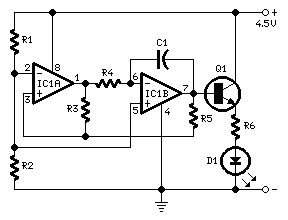873
FREE
circuits!
FREE
circuits!
How to build LED or Lamp Pulser
October 27, 2010 - category: Light flasherAstonishing effect
4.5V supply
Circuit diagram
Parts:
- R1,R2 4K7 1/4W Resistors
- R3 22K 1/4W Resistor
- R4 2M2 1/4W Resistor (See Notes)
- R5 10K 1/4W Resistor
- R6 47R 1/4W Resistor (See Notes)
- C1 1µF 63V Polyester Capacitor
- D1 5mm. Red LED (See Notes)
- IC1 LM358 Low Power Dual Op-amp
- Q1 BC337 45V 800mA NPN Transistor
Circuit operation:
- This circuit operates a LED in pulsing mode, i.e. the LED goes from off state, lights up gradually, then dims gradually, etc.
- This operation mode is obtained by a triangular wave generator formed by two op-amps contained in a very cheap 8 pin DIL case IC. Q1 ensures current buffering, in order to obtain a better load drive.
- R4 & C1 are the timing components: using the values shown in the parts list, the total period is about 4 seconds.
Notes:
- The most satisfying results are obtained adopting for R4 a value ranging from 220K to 4M7.
- Adopting for R4 a value below 220K, the pulsing effect will be indistinguishable from a normal blinking effect.
- The LED can be any type and color.
- You can use a filament lamp instead, provided its features are comprised in the range 3.2 to 6V, 200mA max.
- Using a lamp as a load, R6 must be omitted.
- Voltage supply range can be 4 to 6V: 4.5V is the best compromise.
- Don't supply the circuit with voltages exceeding 6V: it will work less good and Q1 could be damaged when a lamp was used as the load.
- At 6V supply, increase R6 value to 100 Ohm.
author: RED Free Circuit Designs
circuit from http://www.redcircuits.com/



 This category
This category